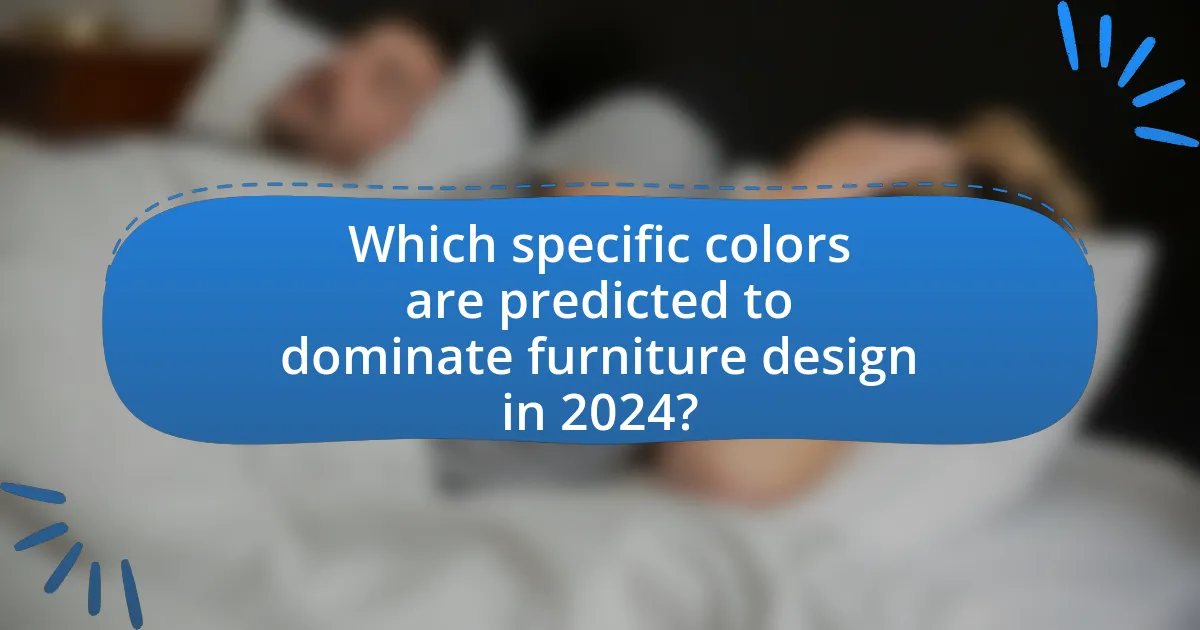The article focuses on anticipated color trends in furniture for 2024, highlighting the dominance of earthy tones, vibrant jewel colors, and soft pastels. It explores how these trends reflect broader design movements, historical influences, and cultural shifts, emphasizing the impact of consumer preferences and sustainability on color selections. Key colors predicted to trend include terracotta, olive green, and deep blue, with a growing preference for warm neutrals and the effective use of color combinations to enhance aesthetics. The article also discusses practical considerations for consumers in selecting colors that align with personal style and current trends.

What are the anticipated color trends in furniture for 2024?
Anticipated color trends in furniture for 2024 include earthy tones, vibrant jewel colors, and soft pastels. Earthy tones such as terracotta, olive green, and warm beige are expected to dominate, reflecting a growing preference for natural aesthetics and sustainability. Vibrant jewel colors like emerald green, sapphire blue, and deep burgundy will also gain popularity, adding richness and depth to interiors. Additionally, soft pastels, including muted pinks and light blues, will provide a calming effect, appealing to those seeking tranquility in their living spaces. These trends are supported by industry forecasts from design experts and color authorities, indicating a shift towards colors that evoke comfort and connection to nature.
How do color trends in furniture reflect broader design movements?
Color trends in furniture reflect broader design movements by serving as visual indicators of cultural shifts and aesthetic preferences. For instance, the rise of minimalism in the late 20th century led to a preference for neutral tones and simple forms, emphasizing functionality and simplicity. This trend is evidenced by the popularity of colors like white, gray, and beige in furniture design, which align with the minimalist ethos of decluttering and creating serene spaces. Additionally, the resurgence of bold colors in recent years, such as deep greens and vibrant blues, mirrors the growing interest in biophilic design and sustainability, as these colors evoke a connection to nature. This correlation between color choices and design movements illustrates how furniture color trends not only reflect current tastes but also respond to societal values and environmental considerations.
What historical influences shape the 2024 color palette?
The 2024 color palette is shaped by historical influences such as the resurgence of mid-century modern aesthetics, the impact of the 1970s color revival, and the minimalist trends from the early 2000s. Mid-century modern design emphasizes earthy tones and vibrant accents, reflecting a desire for nostalgia and comfort. The 1970s revival introduces bold colors like terracotta and mustard, appealing to a sense of individuality and warmth. Additionally, the minimalist trends from the early 2000s promote neutral shades and soft pastels, emphasizing simplicity and tranquility in design. These historical influences collectively inform the 2024 color palette, creating a blend of nostalgia, vibrancy, and calmness in furniture design.
How do cultural shifts impact color choices in furniture design?
Cultural shifts significantly influence color choices in furniture design by reflecting societal values, preferences, and trends. For instance, the rise of minimalism and sustainability in recent years has led to a preference for neutral and earthy tones, which symbolize simplicity and environmental consciousness. According to a report by the Color Marketing Group, colors like soft greens and warm beiges have gained popularity as they resonate with the growing emphasis on wellness and natural living. Additionally, cultural movements, such as the increased focus on diversity and inclusivity, have introduced vibrant and bold colors that celebrate individuality and cultural heritage, impacting design choices across various demographics.
What role do consumer preferences play in shaping color trends?
Consumer preferences significantly influence color trends by dictating which hues are favored in the market. As consumers express their desires through purchasing behavior, manufacturers and designers respond by incorporating these popular colors into their products. For instance, a survey by the Pantone Color Institute revealed that colors reflecting comfort and tranquility, such as soft blues and greens, gained popularity during times of uncertainty, directly impacting design choices in furniture for 2024. This responsiveness to consumer sentiment ensures that color trends evolve in alignment with societal moods and preferences, reinforcing the connection between consumer choices and market offerings.
How are sustainability and eco-friendliness influencing color selections?
Sustainability and eco-friendliness are significantly influencing color selections by promoting natural, earthy tones and materials that reflect environmental consciousness. Designers are increasingly opting for colors like muted greens, browns, and soft blues, which evoke a sense of connection to nature and align with sustainable practices. This shift is supported by consumer demand for products that not only look good but also contribute to environmental well-being, as evidenced by a 2022 survey from the Global Sustainability Institute, which found that 70% of consumers prefer brands that prioritize eco-friendly materials and practices.
What demographic factors are driving color trend changes in furniture?
Demographic factors driving color trend changes in furniture include age, income level, and cultural influences. Younger consumers, particularly millennials and Gen Z, tend to favor bold and vibrant colors that reflect their desire for individuality and self-expression. In contrast, older demographics often prefer neutral and classic tones, which align with their established tastes and preferences. Additionally, higher income levels correlate with a greater willingness to experiment with unique color palettes, while cultural backgrounds influence color choices based on traditional associations and meanings. For instance, studies show that cultural heritage can dictate preferences for specific colors, impacting overall market trends in furniture design.

Which specific colors are predicted to dominate furniture design in 2024?
In 2024, specific colors predicted to dominate furniture design include earthy tones like terracotta, warm neutrals such as beige and taupe, and vibrant shades like deep green and rich blue. These colors reflect a growing trend towards natural and organic aesthetics, aligning with consumer preferences for sustainability and comfort in home environments. The emphasis on earthy tones is supported by design forecasts from industry leaders, indicating a shift towards creating calming and inviting spaces.
What are the key colors expected to trend in 2024 furniture?
The key colors expected to trend in 2024 furniture include earthy tones, soft pastels, and vibrant jewel shades. Earthy tones such as terracotta and olive green are gaining popularity as they evoke a sense of nature and sustainability. Soft pastels like lavender and mint green are anticipated to create calming environments, while vibrant jewel shades such as emerald and sapphire are expected to add a touch of luxury and boldness to interiors. These trends reflect a growing consumer preference for comfort, warmth, and individuality in home decor.
How do warm tones compare to cool tones in the upcoming trends?
Warm tones are expected to dominate upcoming trends in furniture for 2024, contrasting with the more subdued cool tones. This shift towards warm tones is driven by a growing preference for comfort and coziness in interior design, as evidenced by recent surveys indicating that consumers favor colors that evoke warmth and familiarity. In contrast, cool tones, while still present, are anticipated to take a backseat, often used as accents rather than primary colors. This trend aligns with psychological studies showing that warm colors can enhance feelings of happiness and relaxation, making them more appealing in home environments.
What neutral colors are gaining popularity in furniture for 2024?
The neutral colors gaining popularity in furniture for 2024 include warm beige, soft taupe, and muted greys. These shades are favored for their versatility and ability to create calming environments. According to design forecasts, warm beige and soft taupe provide a cozy atmosphere, while muted greys offer a modern touch, making them ideal for various interior styles. The trend reflects a shift towards creating serene spaces that promote relaxation and comfort, aligning with consumer preferences for more tranquil home environments.
How do color combinations enhance furniture aesthetics?
Color combinations enhance furniture aesthetics by creating visual harmony and evoking specific emotions. When complementary colors are used, they can draw attention to the furniture piece, making it a focal point in a room. For example, pairing a deep blue sofa with warm orange cushions can create a striking contrast that adds depth and interest. Research indicates that color theory plays a significant role in design; studies show that colors can influence mood and perception, with certain combinations promoting feelings of calmness or energy. Therefore, thoughtful color combinations not only improve the visual appeal of furniture but also enhance the overall ambiance of a space.
What are the most effective color pairings for modern furniture?
The most effective color pairings for modern furniture include combinations such as navy blue and mustard yellow, gray and blush pink, and black and white. These pairings create a contemporary aesthetic that balances boldness with subtlety, appealing to modern design sensibilities. For instance, navy blue and mustard yellow provide a striking contrast that energizes a space, while gray and blush pink offer a softer, more sophisticated look. Black and white remain timeless, providing versatility and a clean backdrop for various styles. These combinations are supported by design trends that emphasize minimalism and the use of color to create focal points in interior spaces.
How can contrasting colors be used to create visual interest?
Contrasting colors can create visual interest by enhancing the perception of depth and drawing attention to specific elements within a design. When used strategically, such as pairing complementary colors like blue and orange, designers can create a dynamic interplay that captivates the viewer’s eye. Research in color theory indicates that high contrast can evoke emotional responses and stimulate visual engagement, making spaces feel more vibrant and lively. For instance, a study published in the Journal of Environmental Psychology found that contrasting colors in interior design can significantly influence mood and perception, reinforcing the effectiveness of this technique in furniture design for 2024.

What practical considerations should consumers keep in mind regarding color trends?
Consumers should consider the longevity and versatility of color trends when selecting furniture. Choosing colors that are timeless and adaptable ensures that pieces remain relevant and can complement various styles over time. For instance, neutral tones like beige or gray have consistently been popular due to their ability to blend with different decor styles, as evidenced by a 2022 survey from the Color Marketing Group, which indicated that 70% of consumers prefer neutral palettes for long-term investments. Additionally, consumers should assess how color affects mood and space perception; lighter colors can make a room feel larger and more open, while darker shades can create a cozy atmosphere. Understanding these factors helps consumers make informed decisions that align with both current trends and personal preferences.
How can consumers choose colors that suit their personal style?
Consumers can choose colors that suit their personal style by identifying their preferences and understanding color psychology. Personal preferences can be assessed through self-reflection on favorite colors, styles, and the emotions associated with different hues. Color psychology indicates that colors evoke specific feelings; for instance, blue often conveys calmness, while red can signify energy. By considering these factors, consumers can select colors that resonate with their identity and enhance their living spaces. Additionally, tools like color swatches and online visualizers can help consumers visualize how different colors will look in their environment, ensuring a more informed choice.
What tips can help in selecting furniture colors for small spaces?
To select furniture colors for small spaces, choose light and neutral shades to create an illusion of openness. Light colors reflect more light, making the space feel larger and more airy. Additionally, consider using a monochromatic color scheme, which can unify the space and reduce visual clutter. Incorporating pops of color through accessories can add interest without overwhelming the area. According to design experts, using mirrors can also enhance the effect of light colors by reflecting them, further contributing to the perception of space.
How do lighting conditions affect color perception in furniture?
Lighting conditions significantly influence color perception in furniture by altering how colors are viewed under different light sources. For instance, natural daylight enhances the vibrancy of colors, making them appear more saturated and true to their original hue, while incandescent lighting can warm colors, giving them a yellowish tint. Studies have shown that the color temperature of light, measured in Kelvin, affects the appearance of furniture colors; warmer lights (around 2700K) can make colors look softer, while cooler lights (above 5000K) can create a more stark and contrasting appearance. This variability in perception is crucial for consumers and designers when selecting furniture, as the same piece can look entirely different depending on the lighting environment.
What are the best practices for incorporating color trends into existing decor?
To effectively incorporate color trends into existing decor, start by selecting a color palette that complements your current furnishings and overall aesthetic. This can be achieved by using accent pieces, such as throw pillows, artwork, or decorative accessories, in trendy colors to create visual interest without overwhelming the space. Research indicates that using a maximum of three colors from the trend palette helps maintain harmony while allowing for seasonal updates. Additionally, consider the psychology of color; for instance, blues and greens promote calmness, while warm tones like reds and oranges can energize a room. By strategically integrating these colors, you can refresh your decor while ensuring it remains cohesive and inviting.
How can accent pieces be used to introduce trendy colors?
Accent pieces can be used to introduce trendy colors by strategically incorporating items such as throw pillows, rugs, or artwork that feature the desired hues. These elements allow for a flexible and cost-effective way to refresh a space without committing to larger furniture pieces. For instance, if a trendy color like deep teal is popular in 2024, adding a few teal cushions or a patterned rug can instantly update the room’s aesthetic. This method is supported by interior design principles that emphasize the impact of color in small doses, making it easier to adapt to changing trends.
What mistakes should be avoided when updating furniture colors?
When updating furniture colors, avoid choosing shades that clash with existing decor. Selecting colors that do not harmonize can create a disjointed aesthetic, diminishing the overall appeal of the space. Additionally, neglecting to consider the room’s lighting can lead to unexpected results; colors may appear differently under natural versus artificial light. Failing to test paint or fabric samples in the actual environment can result in dissatisfaction with the final outcome. Lastly, overlooking current color trends can make the space feel outdated; for instance, in 2024, earthy tones and soft pastels are expected to be popular, so ignoring these trends may affect the room’s modernity.
How can consumers stay informed about evolving color trends in furniture?
Consumers can stay informed about evolving color trends in furniture by following design blogs, subscribing to industry newsletters, and engaging with social media platforms focused on interior design. Design blogs often feature trend forecasts and expert opinions, while newsletters from furniture retailers and design organizations provide updates on new collections and color palettes. Social media platforms like Instagram and Pinterest showcase real-time trends through user-generated content and influencer posts, allowing consumers to see how colors are being used in various settings. Additionally, attending trade shows and exhibitions can offer firsthand insights into upcoming trends, as these events often highlight innovative designs and color schemes from leading brands.
What resources are available for tracking color trends in interior design?
Resources for tracking color trends in interior design include color forecasting services, design magazines, and online platforms. Notable color forecasting services like Pantone and Sherwin-Williams provide annual trend reports that analyze color usage across various industries, including interior design. Design magazines such as Architectural Digest and Elle Decor regularly feature articles on emerging color trends and expert opinions. Additionally, online platforms like Pinterest and Instagram allow designers to observe real-time trends through user-generated content, showcasing popular color palettes and design styles. These resources collectively offer valuable insights into the evolving landscape of color trends in interior design.
How can social media influence color trend awareness among consumers?
Social media significantly influences color trend awareness among consumers by providing a platform for rapid dissemination of visual content and trends. Platforms like Instagram and Pinterest allow users to share and discover color palettes, design inspirations, and trending aesthetics, which can shape consumer preferences. For instance, a study by the Color Marketing Group found that 80% of consumers are influenced by social media when making color-related decisions in home decor. This demonstrates that social media not only showcases emerging color trends but also actively engages consumers in the conversation around color choices, leading to increased awareness and adoption of specific colors in furniture and design.


